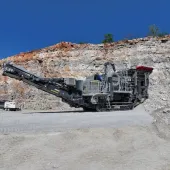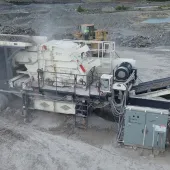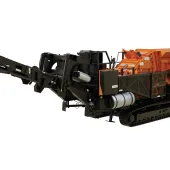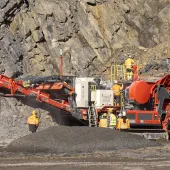Antarctic expedition for Sandvik mobiles
Mobile crusher and screen provide support for British Antarctic Survey’s scientific research
UK engineering contractors BAM have been working with the Antarctic Infrastructure Modernisation Programme (AIMP) on a large infrastructure project in the Antarctic. For this programme, Sandvik were selected as the partner of choice to supply a mobile crusher and screen for a runway resurfacing project to enable further exploration in the region.
BAM Ritchies is the ground engineering division of BAM UK and Ireland, who provide fully integrated services for a wide range of customers, both public and private sector, from small local projects to national critical infrastructure. Over 60 years, they have built a reputation as the go-to ground engineering team for complex problem solving and best-value, sustainable delivery. As the UK’s largest drilling and blasting contractor, they are responsible for more than 40% of contracts in the UK.
It was in 2017 when BAM were selected by the British Antarctic Survey (BAS) as a partner for the Antarctic Infrastructure Modernisation Programme (AIMP), which represents one of the largest UK government investments in polar science infrastructure since the 1980s. It will transform how the British Antarctic Survey enables and supports frontier science and ensure that Britain remains at the forefront of climate, biodiversity and ocean research in the polar regions.
Joined by BAS technical advisors Ramboll and their designers Sweco, BAM were chosen by UK Research Innovation (UKRI) and National Environment Research Council (NERC) to partner with British Antarctic Survey for the £300 million infrastructure programme, which will span a seven-year framework.
Part of the project was the modernization of Rothera Research Station, BAS’ largest facility and a centre for biological research and hub for supporting deep-field and air operations. This redevelopment includes a new science and operations facility, the Discovery Building, as well as the rebuilding and updating of the wharf, together with the introduction of carbon-reducing technology.
BAM were in need of a processing train to crush and screen the abrasive granodiorite material for the runway resurfacing project at the research station. Already familiar with Sandvik mobile equipment and experienced in the use Sandvik Hydrocone crushing technology, Jan Cordon, contracts manager for drilling and blasting at BAM Ritchies, and Harry McMullan, quarry manager for the project, contacted Sandvik Mobile Crushing and Screening.
For this particular application, a Sandvik QH332 Hydrocone crusher and QA335 Doublescreen were selected owing to their versatility and performance. The equipment is being used to make a resurfacing material for an 800m unpaved runway. The –80mm feed material (which was previously crushed on site by a QJ341 jaw crusher) is processed to produce a 0–16mm surface course, 0–25mm basecourse, 0–75mm levelling course and –100mm sub-base.
The Sandvik QH332 is a tracked, self-propelled cone crusher designed for versatility, safety and high performance. Featuring the Sandvik Hydrocone crusher, it comes with a choice of six different crushing chambers and a variety of different bush settings, giving it the adaptability to meet the needs of the specific application, which was one of the main reasons why BAM decided to invest in Sandvik.
‘The cone crusher has a wide choice of set-up with different concave and mantle configurations plus different throws, which allows the machine to be adjusted and configured to a wide range of products,’ said Mr McMullan.
In order to accurately screen the material to the required sizes size and remove the fines, a QA335 Doublescreen was selected thanks to its flexibility and screening abilities. The Doublescreen technology features two high-velocity screens where both the primary and secondary screening angles can be adjusted to optimize screening performance and accuracy. With its two independent double-deck screens, this single machine is capable of performing two screening processes.
Living and working in the Antarctic is no mean feat with temperatures ranging from +5C to –40C. To ensure the Sandvik mobile units were able to operate in this extreme climate, both units were fitted with an arctic package, and Mr McMullan says they have had no issues with their operation and have been pleased with their performance. ‘Both machines have performed exceptionally well considering the harsh environment they are working in,’ he remarked.
Due to the remote location and nature of the application, aftermarket support has been crucial in ensuring the success of the project. This has been vital both in terms of having technical service available when required and also the right spare parts and consumables on the ground when the need arises. ‘Support from Sandvik service engineers has been excellent and they have been available on the phone when required. I wouldn’t hesitate to recommend Sandvik as a supplier,’ said Mr McMullan.










